Java와 함께 제공되는 4가지 스레드 풀은 무엇입니까?
- WBOYWBOYWBOYWBOYWBOYWBOYWBOYWBOYWBOYWBOYWBOYWBOYWB앞으로
- 2023-04-24 19:52:062447검색
Java에서 미리 정의된 네 가지 스레드 풀은 무엇입니까?
newSingleThreadExcutor: 단일 스레드 수를 갖는 스레드 풀(코어 스레드 수 = 최대 스레드 수 = 1)
newFixedThreadPool: 고정된 스레드 수를 갖는 스레드 풀(코어 스레드 수 = 최대 스레드 수 = 사용자 지정) )
-
newCacheThreadPool: 캐시 가능한 스레드 풀(코어 스레드 수 = 0, 최대 스레드 수 = Integer.MAX_VALUE)
newScheduledThreadPool: 예약된 또는 주기적 작업을 지원하는 스레드 풀(코어 스레드 수 = 사용자 정의, 최대 스레드 수 = 정수 .MAX_VALUE)
네 가지 스레드 풀의 차이점은 무엇입니까?
위의 4개 스레드 풀 클래스는 모두 ThreadPoolExecutor를 상속하고 생성 시 새로운 ThreadPoolExecutor(매개변수)를 직접 반환합니다. 차이점은 정의된 ThreadPoolExecutor(매개변수)의 매개변수가 다르며 ThreadPoolExecutor는 ExecutorService 인터페이스 클래스를 상속합니다
-
newFixedThreadPool
Definition:
xecutorService executorService=Executors.newFixedThreadPool(2);
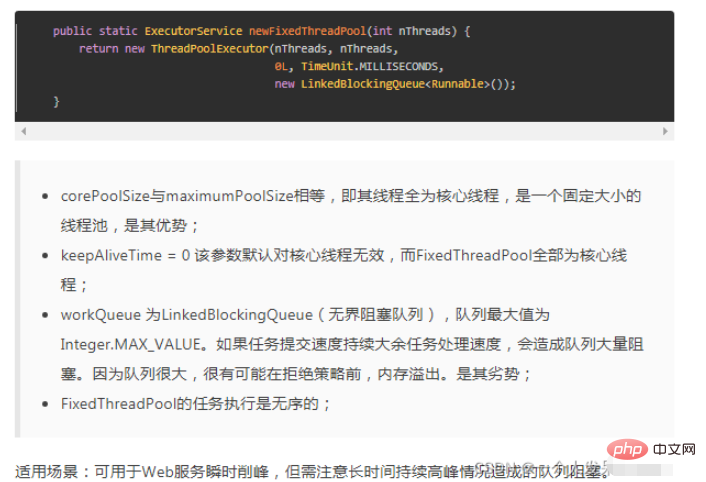
단점: LinkBlockQueue의 연결 목록 차단 대기열을 사용하는 경우 작업의 누적 속도가 처리 속도보다 빠릅니다. , 그것 작업이 축적되어 실패하기 쉽습니다
newSingleThreadExecutor
Definition: ExecutorService executorService =Executors.newSingleThreadExecutor();

위 코드는 새로운 FixThreadP와 같습니다. 이런(1), 그러나 차이점은 Layer FinalizedDelegatedExecutorService가 하나 더 있기 때문에 그 기능은 다음과 같습니다.

fixedExecutorService의 본질은 ThreadPoolExecutor이므로fixedExecutorService를 ThreadPoolExecutor로 강제할 수 있지만 SingleExecutorService는 ThreadPoolExecutor와 아무 관련이 없음을 알 수 있습니다. , 따라서 강제 전송이 실패하므로 newSingleThreadExecutor() 일단 생성되면 스레드 풀 매개변수를 수정하여 실제로 단일 스레드를 달성할 수 없습니다.
단점: LinkBlockQueue의 연결 목록 차단 대기열을 사용하면 작업의 누적 속도가 처리 속도보다 빠르면 작업이 누적되어 OOM 메모리 오버플로가 발생하기 쉽습니다.
newCacheThreadPool
정의: ExecutorService executorService=Executors.newCacheThreadPool ();
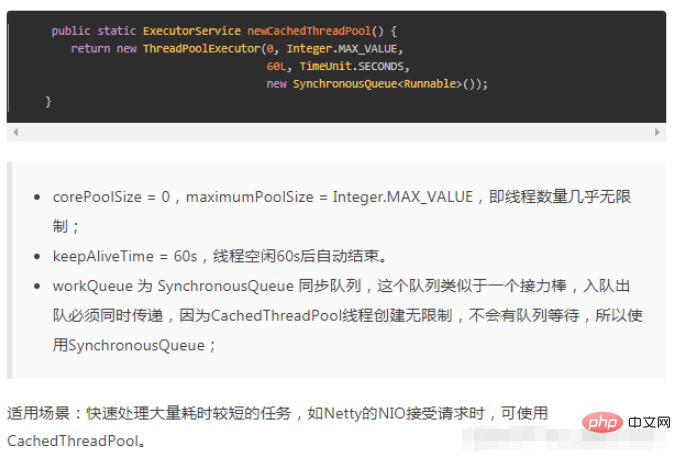
단점: 동기 대기열은 BlockingQueue의 구현이기도 합니다. 최대 스레드 수가 Integer.MAX_VALUE이므로 스레드가 너무 많으면 OOM 메모리 오버플로가 발생하기 쉽습니다.
ScheduledThreadPool
Definition: ExecutorService executorService=Executors.newScheduledThreadPool(2);
源码:
public static ScheduledExecutorService newScheduledThreadPool(int corePoolSize) {
//ScheduledThreadPoolExecutor继承ThreadPoolExecutor
return new ScheduledThreadPoolExecutor(corePoolSize);
}
public ScheduledThreadPoolExecutor(int corePoolSize) {
//ScheduledThreadPoolExecutor继承ThreadPoolExecutor,故super()会调用ThreadPoolExecutor的构造函数初始化并返回一个ThreadPoolExecutor,而ThreadPoolExecutor使实现ExecutorService接口的
//最终ScheduledThreadPoolExecutor也和上面几种线程池一样返回的是ExecutorService接口的实现类ThreadPoolExecutor
super(corePoolSize, Integer.MAX_VALUE, 0, NANOSECONDS,
new DelayedWorkQueue());
}스레드 풀의 중요한 매개변수는 무엇입니까?
ThreadPoolExecutor 구성 방법은 다음과 같습니다.
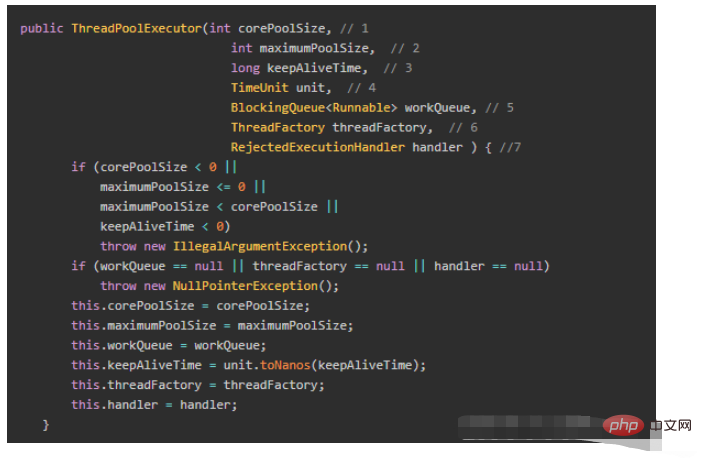
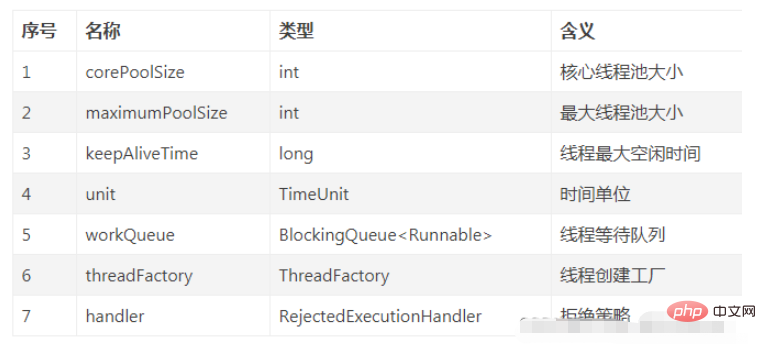
keepAliveTime은 현재 스레드 수가 [코어 스레드 수, 최대] 사이일 때 이러한 비코어 스레드가 작업 없이 유휴 시간을 기다리는 시간을 나타냅니다. 스레드 수], 스레드 풀을 종료하면 됩니다.
대기 대기열의 크기는 최대 스레드 수와 관련이 없습니다. 스레드 생성 우선 순위 = 코어 스레드 > 차단 대기열 > 확장 스레드(현재 스레드 수 코어 스레드가 최대 스레드 수보다 작습니다. 스레드를 확장하려면)
코어 스레드 수는 5개, 대기 대기열 길이는 3개, 최대 스레드 수는 10개라고 가정합니다. 스레드 수가 계속해서 늘리고, 먼저 5개의 코어 스레드를 생성한 다음 코어 스레드 수가 가득 차면 스레드를 던집니다. 대기열이 손실되기를 기다리고, 대기열이 가득 차기를 기다립니다(3 스레드). 이때 최대 개수는 스레드입니다. 스레드를 비교합니다(큐가 손실될 때까지 기다리는 최대 스레드 수가 나타날 수 있는 경우에만). 스레드 수가 최대 스레드 수를 초과하는 경우 계속해서 2개의 스레드(5+3+2)를 생성할 수 있습니다. , 거부 정책이 실행됩니다.
코어 스레드 수가 5개, 대기 큐 길이가 3개, 최대 스레드 수가 7개인 경우: 스레드 수가 계속 증가하면 코어 스레드 5개를 생성합니다. 먼저 코어 스레드 수가 가득 차면 스레드가 대기 대기열에 던져집니다. 대기 대기열에 스레드가 2개 있으면 최대 스레드 수에 도달하지만(5+2=7) 대기 대기열은 없습니다. 아직 가득 차 있으므로 최대 스레드 수에 대해 걱정할 필요가 없습니다. 대기 큐가 가득 찰 때까지(차단된 스레드 3개) 최대 스레드 수를 비교합니다(대기 큐가 가득 찼을 때와 최대 스레드 수에 한함). 스레드 종료 가능) 이때 코어 + 대기 큐 = 5+3=8>7= 최대 스레드 수, 즉 최대 스레드 수에 도달하면 거부 정책이 실행됩니다
-
대기 대기열이 LinkedBlockingQueue 무제한 대기열로 설정된 경우 이 대기열은 무한하며 해당 단계의 최대 스레드 수에 도달하지 않습니다.
如何自定义线程池
可以使用有界队列,自定义线程创建工厂ThreadFactory和拒绝策略handler来自定义线程池
public class ThreadTest {
public static void main(String[] args) throws InterruptedException, IOException {
int corePoolSize = 2;
int maximumPoolSize = 4;
long keepAliveTime = 10;
TimeUnit unit = TimeUnit.SECONDS;
BlockingQueue<Runnable> workQueue = new ArrayBlockingQueue<>(2);
ThreadFactory threadFactory = new NameTreadFactory();
RejectedExecutionHandler handler = new MyIgnorePolicy();
ThreadPoolExecutor executor = new ThreadPoolExecutor(corePoolSize, maximumPoolSize, keepAliveTime, unit,
workQueue, threadFactory, handler);
executor.prestartAllCoreThreads(); // 预启动所有核心线程
for (int i = 1; i <= 10; i++) {
MyTask task = new MyTask(String.valueOf(i));
executor.execute(task);
}
System.in.read(); //阻塞主线程
}
static class NameTreadFactory implements ThreadFactory {
private final AtomicInteger mThreadNum = new AtomicInteger(1);
@Override
public Thread newThread(Runnable r) {
Thread t = new Thread(r, "my-thread-" + mThreadNum.getAndIncrement());
System.out.println(t.getName() + " has been created");
return t;
}
}
public static class MyIgnorePolicy implements RejectedExecutionHandler {
@Override
public void rejectedExecution(Runnable r, ThreadPoolExecutor e) {
doLog(r, e);
}
private void doLog(Runnable r, ThreadPoolExecutor e) {
// 可做日志记录等
System.err.println( r.toString() + " rejected");
// System.out.println("completedTaskCount: " + e.getCompletedTaskCount());
}
}
static class MyTask implements Runnable {
private String name;
public MyTask(String name) {
this.name = name;
}
@Override
public void run() {
try {
System.out.println(this.toString() + " is running!");
Thread.sleep(3000); //让任务执行慢点
} catch (InterruptedException e) {
e.printStackTrace();
}
}
public String getName() {
return name;
}
@Override
public String toString() {
return "MyTask [name=" + name + "]";
}
}
}运行结果:
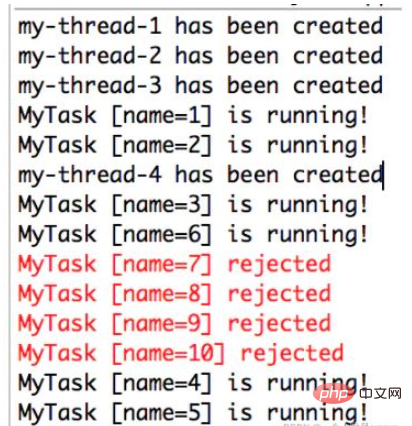
其中7-10号线程被拒绝策略拒绝了,1、2号线程执行完后,3、6号线程进入核心线程池执行,此时4、5号线程在任务队列等待执行,3、6线程执行完再通知4、5线程执行
위 내용은 Java와 함께 제공되는 4가지 스레드 풀은 무엇입니까?의 상세 내용입니다. 자세한 내용은 PHP 중국어 웹사이트의 기타 관련 기사를 참조하세요!

